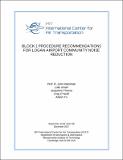| dc.description.abstract | Recent developments in navigation and surveillance technology have enabled new high-precision approach and departure operational procedures using GPS and Required Navigation Performance (RNP) standards. These procedures have proven effective for reducing fuel consumption and streamlining some aspects of air traffic control. However, flight tracks that were previously dispersed over wide areas due to less precise navigation or ATC vectoring are more concentrated on specific published tracks with effects on underlying communities.
This study is an initial investigation to identify potential modifications to approach and departure procedures at Boston Logan International Airport (BOS) which would reduce community noise impact in areas which experience flight track concentration. Potential procedure modifications were separated into two sequential “Blocks”. Block 1 procedures were characterized by clear predicted noise benefits, limited operational/technical barriers and a lack of equity issues. Block 2 procedures exhibit greater complexity due to potential operational and technical barriers as well as equity issues (defined as noise redistribution between communities for the purposes of this study). This report presents recommendations for an initial set of Block 1 procedures. Continued analysis and community outreach will inform the identification and development of Block 2 procedures.
RNAV procedures were implemented at BOS between 2012 and 2013. Candidate approach and departure modifications were first identified based on an analysis of historical flight track densities over the communities surrounding BOS before and after the implementation of new RNAV procedures coupled with noise complaint records and US Census population data. Potential procedure modifications were considered for each identified arrival and departure runway including: lateral flight track adjustment to avoid noise-sensitive areas, vertical trajectory modifications including speed, thrust or configuration management as well as techniques to reintroduce dispersion into flight trajectories.
The technical recommendations presented in this report are not developed to an implementation-ready stage. Rather, the work completed to date represents a preliminary feasibility analysis for each recommended procedure. Prior to implementation of any of these recommendations, the FAA will need to execute internal verification and validation processes. Modifications to the recommended procedures may be required. The noise-reduction objectives for each procedure should be retained in any necessary procedure refinements.
Procedure modification options were assigned to Block 1 or Block 2 based on a preliminary evaluation of noise reduction potential, operational/technical feasibility and potential equity issues. Some candidate procedures were rejected due to safety concerns or lack of noise benefits. The noise analysis compared the proposed modification with current procedures on a single-event basis. Noise contours and corresponding population exposures were calculated for the maximum noise level (LMAX) and Sound Exposure Level (SEL) metrics.
The technical feasibility analysis included an examination of flight safety, aircraft performance, navigation and flight management system (FMS) limitations, pilot workload, ATC workload, and procedure design criteria. The process of procedure identification and refinement was informed by outreach to impacted stakeholders including community representatives, FAA regional and national offices, air traffic control (ATC) managers and specialists, airline technical pilots, and public officials. | en_US |
